#Marquise de Lafayette
Explore tagged Tumblr posts
Text




i kinda miss posting on here tbh
#daveed diggs#daveed daniele diggs#jasmine cephas jones#rafael casal#blindspotting#hamilton#clipping#marquise de lafayette#thomas jefferson#blackish#snowpiercer#lin manual miranda#daveed diggs x reader#jonathan snipes#william hutson#melanie cavill#snowpiercer tnt#andre layton#jaylen barron#candace nicholas lippman#helen hunt#benjamin earl turner
353 notes
·
View notes
Text
─────── ·𖥸· ───────






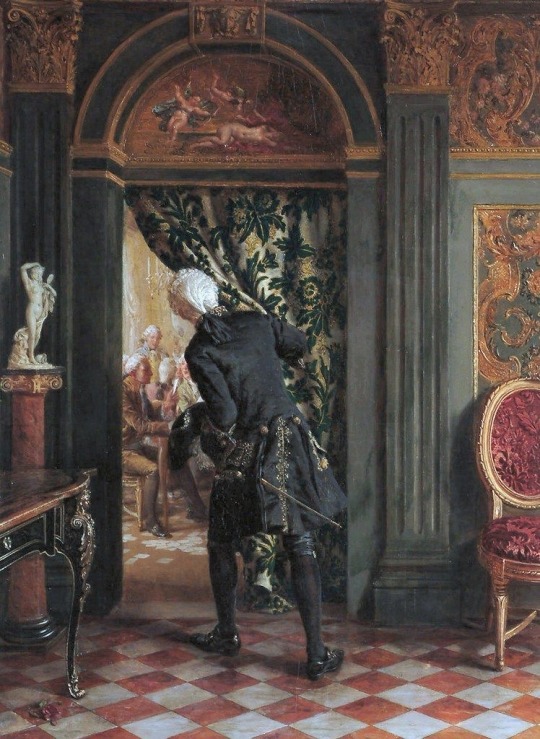

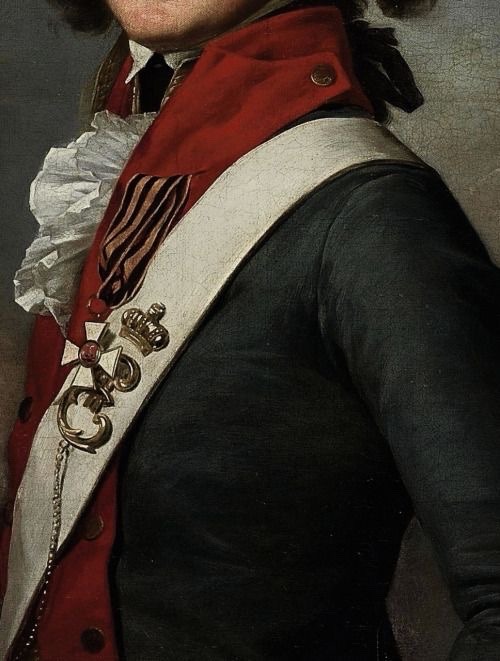
La Marquise Adrienne de Lafayette
─────── ·𖥸· ───────
They called me weak
Like I'm not just somebody's daughter
… Coulda been a nightmare
But it felt like they were right there
And it feels like yesterday was a year ago
But I don't wanna let anybody know
'Cause everybody wants something from me now
And I don't wanna let 'em down
#my girl died on Christmas Eve and she also gave birth to Georges on Christmas Eve so#I’m in my feels sorry folks#adrienne de lafayette#adrienne de noailles#french revolution#american revolution#amrev fandom#amrev#Lafayette#marquis de lafayette#marquise de Lafayette
15 notes
·
View notes
Text
The Story of Adrienne (1800) and Pauline (1797)


I often go on and on about how fascinated I am by the time the La Fayette’s and the Noialles’ spend in exile at the estates Wittmoldt and Lehmkuhlen. Many modern books and publications cover this episode only sparsely – and to be honest, at first glance, events like the American and French Revolution for example appear to be the more interesting, more important and more dramatic chapters in La Fayette’s life. I would like to make the point, that the families time in exile should not be underestimated and that many things happen there, that profoundly influenced the La Fayette’s and their kin. This episode is also a fine example of the family interacting with people outside their usual sphere. People from a different country, a different culture, often with different perceptions.
The other day I was reading a book about Wittmoldt, both the Wittmoldt estate as well as the small village by the same name nearby. The book was written by the head teacher of the local school and a large part of his book deals with the school, its pupils and former teachers throughout time. The book mentions a former head teacher, Detlef Ludwig Petersen, who lived at the Wittmoldt estate during a time where Wittmoldt had many different owners and inhabitants – Madame de Tessé, Adrienne de La Fayette’s aunt, among them.
Now, what is so special about Petersen? He and his wife had four children. Three of them were born in Güsdorf, a neighbouring village, before the Petersen’s moved to Wittmoldt. While living at the Wittmoldt estate they had one last child, a daughter named Adrienne Pauline. My interest was immediately peaked since the name was not only very French – in contrast to the very German names of the first three children, but also the names of the French inhabitants of Wittmoldt at the time.
La Fayette’s wife and her aunt were both named Adrienne and there was also a younger sister, La Fayette’s sister-in-law, who stayed at Wittmoldt and that was named Pauline. This could hardly be a coincidence! I had a look at the archival records and found the entry of Adrienne Pauline’s baptism.
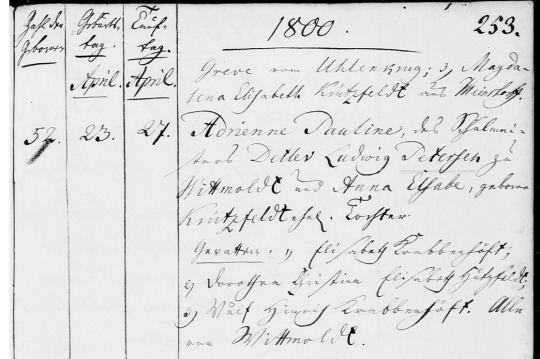
Landeskirchliches Archiv der Evang.-Luth. Kirche, Kirchenkreis Plön-Segeberg, Plön, Taufen 1764-1800, p. 247.
The child was born on April 23, 1800 and baptised four days later on April 27.
But wait! That is not all!
While going through the records, I found a second child with a name too extraordinary to be a coincidence.
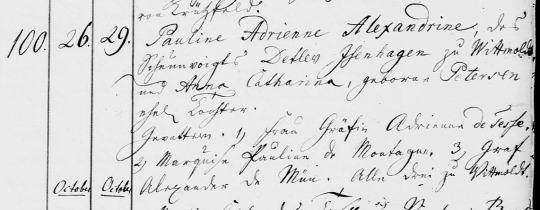
Landeskirchliches Archiv der Evang.-Luth. Kirche, Kirchenkreis Plön-Segeberg, Plön, Taufen 1764-1800, p. 203.
Pauline Adrienne Alexandrine was born on September 23, 1797, and baptised on September 29. Not only is her name a direct reference to the two sisters and their aunt, but the record also reveals that both Madame de Tessé, as well as Pauline, Marquise de Montague were witnesses to the proceedings.
The name of Pauline Adrienne Alexandrine’s father does not ring a bell for me, but her mother’s maiden name was Petersen. Now, Petersen is and always has been a very, very common German surname and therefor this could be two different Petersen-families. But Wittmoldt is still a very small village with few inhabitants and things were not looking any different at the turn of the 19th century. It is therefore entirely possible (and in my opinion quite likely) that not one, but two couples in the Petersen-family decided to name their daughter after Adrienne and Pauline.
(I think that the Adrienne, Madame de Tessé, played a bigger role here then Adrienne, Marquise de La Fayette since de Tessé owned Wittmoldt, lived there longer than her niece and was directly referred by name in the records of the 1797 baptism.)
This might not be a big and flashy story compared with some of La Fayette’s exploits during the American Revolution for example, but I like to believe that this is a very human story. The little things, the silent connections that speak of respect and intimate relationships - stories that are history without making history.
#marquis de lafayette#resources#la fayette#lafayette#french history#american history#history#french revolution#madame de tessé#pauline marquise de montague#1797#1800#detlef ludwing petersen#wittmoldt#lafayette in exile
18 notes
·
View notes
Text
Introducing my Homestuck OC

Marquise Spinneret Lafayette
#homestuck#marquise spinneret mindfang#mindfang#hs#marquis de lafayette#lafayette hamilton#hamilton musical#hamilton
8 notes
·
View notes
Text
Lafayette’s kids doing their homework:

#La marquise#lafayette#marquis de lafayette#adrienne de noailles#adrienne de lafayette#amrev crack#amrev memes
115 notes
·
View notes
Text






“‘I send you a few lines here, dear heart.’ He was writing to his wife, not me.” “Thank you for the clarification.” “‘I must tell you we fought with earnest but were not the victors. The English honored me with a musket ball in the leg, but the wound is nothing, and I hope you will not worry.’ Uh—it says ‘dear heart’ again. ‘Let all my friends know I am in good health, I love you more than ever.’” “No ‘dear heart’?" “I left that out.”
— Gilbert du Motier, Marquis de Lafayette, to Adrienne de Noailles, Marquise de Lafayette, 12 September 1777
1x03, FRANKLIN (2024)
#franklin#franklinedit#appletvsource#appletvgifs#appletvedit#perioddramaedit#perioddramagif#weloveperioddrama#lafayette#marquis de lafayette#gilbert du motier#adrienne de lafayette#tv#mine#period drama#american revolution#tvedit#perioddramasource#perioddramacentral#the one direct mention of adrienne in this show#what do i need to do to see her actually on screen
40 notes
·
View notes
Text
about me!!
!!MINOR!!
name: alice
gender: female, she/her (cis-gender)
sexuality: aroace
nicknames: (given by my friends) creature, feral child, child
things i fw: amerev, frev, hamilton an american musical, six, heathers, liberty kids, turn, lafayettes family, the laurens family, music
people i fw: my friends, the marquis and the marquise de lafayette, john laurens
timezone: est
what do i do here?: probably post my amrev projects and talk about my life 🤷♀️
tw: in casual conversations my spelling is absolutely terrible :( i may also have a speech impediment :(( i also us brainrot in a satire way!!
#intro post#amrev#frev#marquis de lafayette#adrienne de lafayette#john laurens#turn washington's spies#liberty kids#heathers#six the musical
8 notes
·
View notes
Text
“France is in the throes of violent birth”: Thomas Jefferson and the 1789 French Revolution

"The deputies retired, the people rushed against the place, and almost in an instant were in possession of a fortification, defended by 100 men, of infinite strength..."
• Ambassador Thomas Jefferson report on the events on 14 July 1789.
The excerpt shown here is from a letter in Jefferson’s own hand to Secretary of Foreign Affairs John Jay. In great depth, he describes the events of July 14, 1789, including the storming of the Bastille in Paris. The Bastille was a symbol of the old regime, and housed arms, gunpowder, and prisoners.
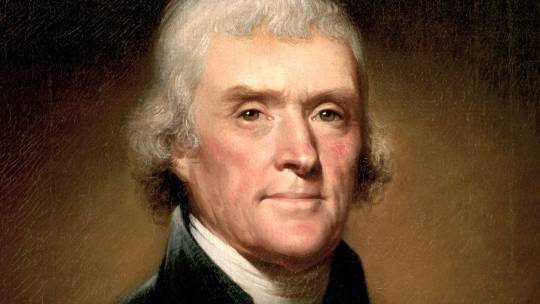
On 14 July 1789, the U.S. Ambassador to France, Thomas Jefferson, was a witness to the events of a day in Paris that is commonly associated with the beginning of the French Revolution. Jefferson recorded the events of the day in a lengthy and detailed letter to John Jay, then Secretary of Foreign Affairs.
The American Revolutionary War began as a conflict between the colonies and England. In time, what began as a civil disturbance turned into a world war drawing France, Spain, and the Netherlands into the hostilities. France would send troops, ships, and treasure to support the American effort. During the war, one of the first priorities of the French government and its allies was to raise funds to fight the war.
When the Treaty of Paris was signed in 1783, France was virtually broke and on the edge of social catastrophe, the result of decades of war with England and other countries. The poor suffered hunger and privation. By 1789, revolution would come to France.

In 1785, Thomas Jefferson arrived in Paris to replace Benjamin Franklin, who was retiring as ambassador to France. At the age of 81, Franklin returned to the United States where he would serve as President of the Pennsylvania Assembly and also participated in the Constitutional Convention of 1787.
John Adams was reassigned to London where he would be the first American ambassador to the Court of St. James. Jefferson remained on duty in France until late 1789 when he returned to the United States. While in France, Jefferson reported on developments at the court of King Louis XVI, the country at large, and the rest of Europe.
Jefferson was sympathetic to the revolution, opening his home in Paris to its leaders and assisting his friend the Marquis de Lafayette with drafting the Declaration of the Rights of Man. As the first Secretary of State under the Constitution and George Washington, his support for France and the revolution continued.
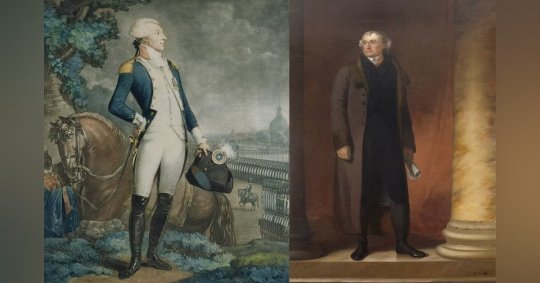
His friendship to the Marquis de Lafayette, who served in the War of Independence and lived almost 10 years in the USA, became very important in the beginning of the French revolution. The Marquis was the General of the french forces 1789 and tried to prevent a civil war and turmoil. He corresponded with Jefferson, who came from a country with the same experiences. Jefferson and the Marquis agreed that France was not mature to become a republic but a constitutional monarchy, like in Great Britain. However, this was the decision of the national assembly, of which the Marquise was a member. Jefferson went daily to Versailles to inform himself about the decisions. During Jefferson’ s visits, they passed the following laws:
1. Freedom of the person by habeas corpus 2. Freedom of conscience 3. Freedom of the press 4. Trial by jury 5. A representative legislature 6. Annual meetings 7. The origination of laws
This totally fit to Jefferson’s principles. In addition, there was passed a bill, which was prepared by Lafayette and Jefferson and which abolish any title or rank to make all men equal.
Thomas Jefferson also helped his friend Lafayette to bring the different opinions in his party about the constitution to an agreement. France should become a constitutional monarchy.
However, after this, Jefferson recognised that he is not allowed to interfere in the French domestic affairs and that he should be neutral and represent his country. He left France in the thinking that the Revolution was over and that France would grow to a constitutional monarchy. Jefferson was proud of the achievements in France and after his return to USA he declared: “ So ask the travelled inhabitant of any nation, In what country on earth would you rather live? - Certainly, in my own where are all my friends, my relations, and the earliest and sweetest affections and recollections of my life. Which would be your second choice? France."
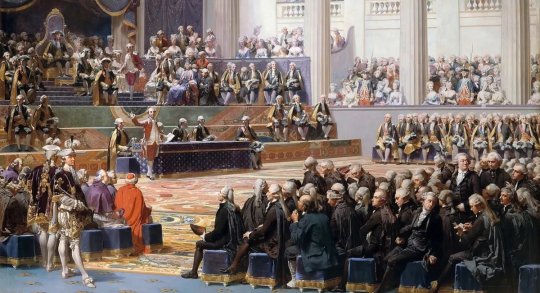
For all his francophile fervour, as the chief American diplomatic representative, Jefferson’s Enlightenment had been a conventionally English one, dominated above all by John Locke. And Jefferson’s first impressions of America’s principal ally in the Revolution were not positive ones. “The nation,” he confided to Abigail Adams in 1787, “is incapable of any serious effort but under the word of command.”
The stars of the French Enlightenment - Voltaire, Diderot, d’Holbach - were frivolous and useful only for manufacturing “puns and bon mots; and I pronounce that a good punster would disarm the whole nation were they ever so seriously disposed to revolt.”
The events of the spring of 1789 soon changed all of that before Jefferson’s very eyes. “The National Assembly,” he excitedly wrote to Tom Paine, “having shewn thro’ every stage of these transactions a coolness, wisdom, and resolution to set fire to the four corners of the kingdom and to perish with it themselves rather to relinquish an iota from their plan of a total change of government” had excited Jefferson’s imagination as nothing before.
Even when the Paris mob seized the Bastille and beheaded the hapless officers of the Bastille, Jefferson shrugged it aside as a mere incident, since “the decapitations” had accelerated the king’s surrender. As Jefferson would write later, “in the struggle which was necessary, many guilty persons fell without the forms of trial, and with them some innocent.” But rather than seeing the French Revolution fail, “I would have seen half the earth desolated. Were there but an Adam and an Eve left in every country and left free, it would be better than as it now is.”

Jefferson’s admiration for the French Revolution seemed to increase in direct proportion to his distance from it. And once he returned to America at the end of 1789, one of his chief motives for taking the post of Secretary of State was to observe and encourage the French eruption, when the National Assembly seized and redistributed the lands of the Catholic Church, when the king foolishly attempted to flee France, only to be captured, placed on trial and executed.
And when a Committee of Public Safety began a national purge - the “reign of terror” - Jefferson continued to describe the French Revolution as part of “the holy cause of freedom,” and sniffed that “the tree of liberty must be refreshed from time to time with the blood of patriots and tyrants. It is its natural manure.”

There is no question that Jefferson’s influence in the beginning of the French Revolution was very important. His initial moderate counsels and ideas helped in the beginning to prevent a civil war. His opinion that France was not mature to become a republic is probably right, because after 600 years of monarchy and aristocracy they people were not used to have any rights or take part in political matters. Jefferson thought that a republic had to develop from a constitutional monarchy. When you look to the cruel end of the French Revolution, Jefferson’s assessment was right up to a point.
Jefferson’s time as Secretary of State coincided with the most explosive phase of the French Revolution. What started as an attempt to dismantle the Ancien Régime and institute a constitutional monarchy blossomed into a radical experiment in creating an entirely new republican society. As his correspondence with Minister to France Gouverneur Morris and Minister to the Netherlands William Short during the emergence of the Jacobin Terror reveals, Jefferson responded to the violent radicalisation of the Revolution with enthusiastic support.
His advocacy for the French Revolution did not signify his emergence as a disruptive insurrectionist in favour of purposeless violence, anarchy and unbridled populism. Instead, he advocated for recognition and support of the Jacobin government as a successful international analog to the republican project he wanted to pursue at home at the expense of the “monarchical” aspirations of Hamilton and the Federalists.
In practice, the parallels he imagined between the ideal Jeffersonian and Jacobin republics were usually more apparent than real, as Jefferson often ignored the reports of Morris and Short in favour of fanciful idealising of his French counterparts – a problem Jefferson would only come to grips with in retirement.
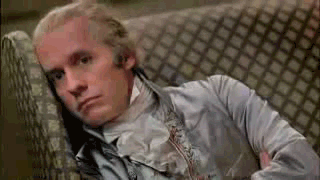
Despite these dilemmas, Jefferson’s impassioned advocacy for the French Revolution proved effective, emerging as a cornerstone of the burgeoning Republican Party’s foreign policy and remaining important well into the early nineteenth century, until the Revolution ceased to be an important political issue. It was not until he became President in 1801 that Jefferson’s views toward France began to cool and became more pragmatic, highlighted by the Louisiana Purchase Treaty.
#thomas jefferson#jefferson#french revolution#14 july 1789#bastille day#america#france#french#monarchy#republic#history#politics#ideology#jacobin#essay#diplomacy#ambassador#jefferson in paris#paris
66 notes
·
View notes
Text

A set of 34mm miniatures of French figures, mostly the French royal family. 18th century. Included: Louis XVI, Marie Antoinette (2 miniatures); The comtesse de Artois; Madame Royale; the comtesse de Provence; Jean Sylvaine de Bailly; Jean-Siffrein Maury; and the marquise de Lafayette. Thies Militaria Auctions, LLC.
101 notes
·
View notes
Note

marquise de lafayette jumpscare 😨😨
woah jumpscare im terrified 😨😨😨😨😨😨😨
2 notes
·
View notes
Text
//I’m writing a historical fiction about Adrienne <3
5 notes
·
View notes
Text





NO ONE TALK TO ME
#daveed diggs#daveed daniele diggs#emmy raver lampman#demmy#hamilton#marquise de lafayette#thomas jefferson#the umbrella academy#allison hargreeves#blindspotting#rafael casal#clipping#daveed diggs x reader#snowpiercer tnt#snowpiercer#angelica schuyler#disney pixar soul#blackish#andre layton#melanie cavill#jennifer connelly#jasmine cephas jones#anthony ramos#lin manual miranda#elliot page#rafael casal x reader#emmy raver lampman x reader#the unbreakable kimmy schmidt
2K notes
·
View notes
Note
Do you know if Adrienne was mad at Lafayette for his affairs?
Dear @mxtallmadge,
I think that “mad” is the wrong word and that “disappointed” is a better fit. That being said, there is little to no written record left by Adrienne concerning her husband’s affairs (that I do know of). She was very private in that regard, so everything is either circumstantial evidence or speculation.
When we look at La Fayette’s affairs, there is plenty of discourse with whom, why and when he had an affair. In an early version of his memoirs there are some allusions to his affairs so we can be certain that there were some. The passage was removed form the final version of his memoirs. Anyway, there are two women histories are convinced La Fayette had affairs with - Diane de Simiane and Aglaé, comtesse d'Hunolstein. But even with these two, there are people who argue that an affair never took place.
We will come back to these two, particular Diane de Simiane, but we first have to take in the context of the time to understand how Adrienne must have felt about La Fayette’s affairs. Because the thing is, theirs was an arranged marriage in 18th century France and they were part of the nobility. Affairs were not uncommon, in fact, sometimes not having an affair was more uncommon than having one. That is not to say that these circumstances make it easier, if you love your partner the way Adrienne loved La Fayette. But she probably was not surprised, after all her own father, uncles, the King – they all had affairs. Her father even boasted that his mistress had formerly been the mistress of Louis XV.
Second, Adrienne had never to fear that La Fayette would abandon her. She was his wife, mother of his only four children, there were no illegitimate children. He loved her and although he strayed, he always returned. There was never any sign of contempt, of displeasure with her, there was no talk of a divorce or a separation. In fact, La Fayette refused to remarry after Adrienne’s death. Again, this not necessarily made Adrienne feel better, but she had at least never to worry that La Fayette would not return. For him his affairs seem more like adventures and less like true romantic affairs. La Fayette wrote in his Memoirs (Vol. 1):
I shall spare you also the confession of an unedifying youth, and even of the story of two romances dedicated to beauties who were then very celebrated, in which my head had a larger part than my heart. The first, scarcely begun, broke against the obstacles of jealousy with which I collided head-on. The other-in which I wanted at first to triumph less over the object herself than over a rival-I pursued, despite long interruptions, on every possible occasion. Our relationship went from esteem all the way to the contrary sentiment, and was finally terminated by a catastrophe unconnected with me. It is more pleasant for me to speak of the tender and stable affection that I never cease to feel for the woman whom I had the good fortune to marry.
Idzerda Stanley J. et al., editors, Lafayette in the Age of the American Revolution: Selected Letters and Papers, 1776–1790, Volume 1, December 7, 1776–March 30, 1778, Cornell University Press, 1977, pp. 3-6.
La Fayette’s affairs (that we know of) and also the occasional flirts later in life were mostly marked by being short and very passionate (to the point of being childish.)
Adrienne most likely learned to accept and live with it, knowing that her place was still secured and that La Fayette spend more time with her and the children than with his mistresses.
But I promised you to come back to Aglaé and Diane. In Virginies Memoirs of her mother there is a letter published, written by La Fayette to one of his closest friends (and at that point also his in-law), Latour-Mabourg. The letter was written in January 1808, shortly after Adrienne’s death and gives great detail about Adrienne’s last days. There are two little passages that are interesting in the context of the question:
She [Adrienne] said to Mme de Simiane: “I was going to have a malignant fever, but I shall be well attended to, and shall get the better of it.”
And the second one:
“The last day she [Adrienne] told me: “When you see Mme de Simiane, give her my love.” Thus her heart was all life when her poor limbs were already numbed by approaching death.
Mme de Lasteyrie, Life of Madame de Lafayette, L. Techener, London, 1872, pp. 397-432.
We can see from these accounts that Diane was around Adrienne and the La Fayette’s in general during this time and that Adrienne did not seem to mind. Diane was a friend of the family, she was close to Adrienne’s aunt, Madame de Tessé and probably also to one of Adrienne’s sisters. But Diane was not only with the La Fayette’s during Adrienne’s last days, she also spend some considerable time with the (extended) family during their exile in Danish-Holstein. She most likely was a guest at Anatsasie’s wedding. In the Memoirs of Adrienne’s sister Anne de Noailles, Marquise de Montagu, we can read that:
Eine Freundin der Gräfin Tessé, die Marquise von Simiane, entfloh mit einem falschen Paß versehen und auf ihrer Reise von einem alten Jakobiner, einem sogenannten Freunde des Herrn von La Fayette, behütet, aus Frankreich; sie kam gegen Ende des Winters [1797/98] nach Witmold und war nicht wenig überrascht, hier, wo sie die Leutchen ziemich traurig anzutreffen wähnte, bei ihrer Ankunft von nichts Anderem als von Heiratsprojekten [the marriage of La Fayette’s oldest daughter Anastasie with Charles Latour-Maubourg] und einer Kindstaufe [The Marquis de Monatgue, Adrienne’s sister was pregnant] zu hören.
Marquise of Montague, Anna Pauline Dominika von Noailles, Marquise von Montague – Ein Lebensbild, Münster, Aschendorff, 1871, p. 203.
My translation:
A friend of the Countess Tessé, the Marquise de Simiane, escaped from France with a false passport and protected on her journey by an old Jacobin, a so-called friend of M. de La Fayette; she came to Witmold towards the end of winter [1797/98] and was not a little surprised to hear of nothing but marriage projects [the marriage of La Fayette’s oldest daughter Anastasie with Charles Latour-Maubourg] and a child's baptism [The Marquis de Monatgue, Adrienne’s sister was pregnant] here, where she thought she found the people rather sad.
There is a second paragraph in the same book:
Frau von Montague, ihrer Entbindung nahe, half ihnen [Adrienne’s children], die glorreichen Wunden ihrer Mutter verbinden; dann, wenn diese Pflicht erfüllt war, beschäftigte sie sich mit dem Brautschatz, mit der Haushaltung und dem Gute [Witmold], gehend und summend; “rund wie ein Thurm”, aber unermüdlich. Man konnte nicht umhin, sie zu bewundern und doch über sie zu lachen. Frau von Simiane, die zugegen war, behauptete, sie würde sicherlich in einem jener großen Schränke, die sie in jedem Augenblick aufmachte, niederkommen.
Marquise of Montague, Anna Pauline Dominika von Noailles, Marquise von Montague – Ein Lebensbild, Münster, Aschendorff, 1871, p. 205.
My translation:
Madame de Montague, near her confinement, helped them bind up their mother's glorious wounds; then, when that duty was done, she occupied herself with the dowry, with the housekeeping, and with the manson, walking and humming; “round as a tower”, but tireless. One could not help admiring her and yet laughing at her. Madame de Simiane, who was present, said she would certainly give birth in one of those large cupboards that she opened at every moment.
You see, La Fayette’s affairs, in the context of their time, his behaviour and the reactions of his friends and family are quite nuanced but I hope I could shine some light in the topic. I hope you have/had a great day!
#ask me anything#mxtallmadge#marquis de lafayette#la fayette#adrienne de lafayette#adrienne de noailles#diane de simiane#virginie de la fayette#anastasie de la fayette#marquise de montague#french history#history#letter
40 notes
·
View notes
Photo
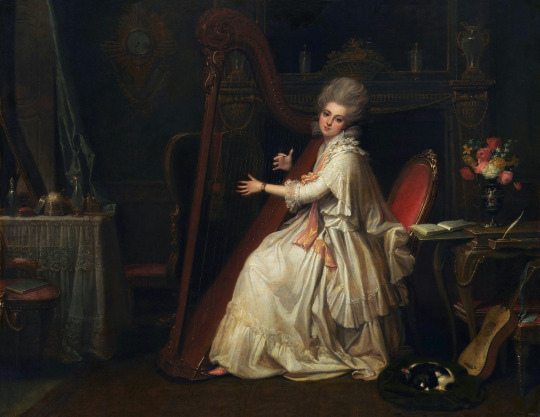
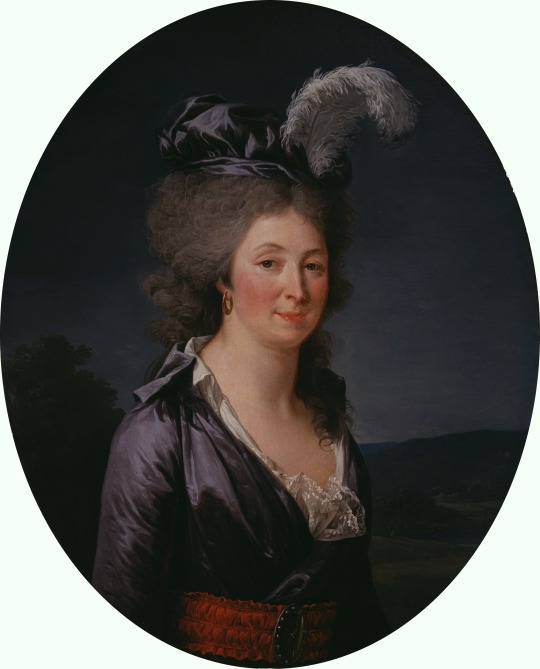
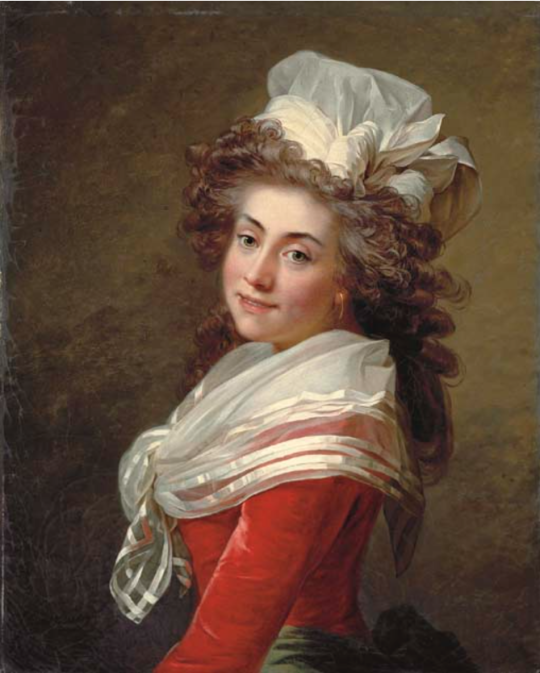

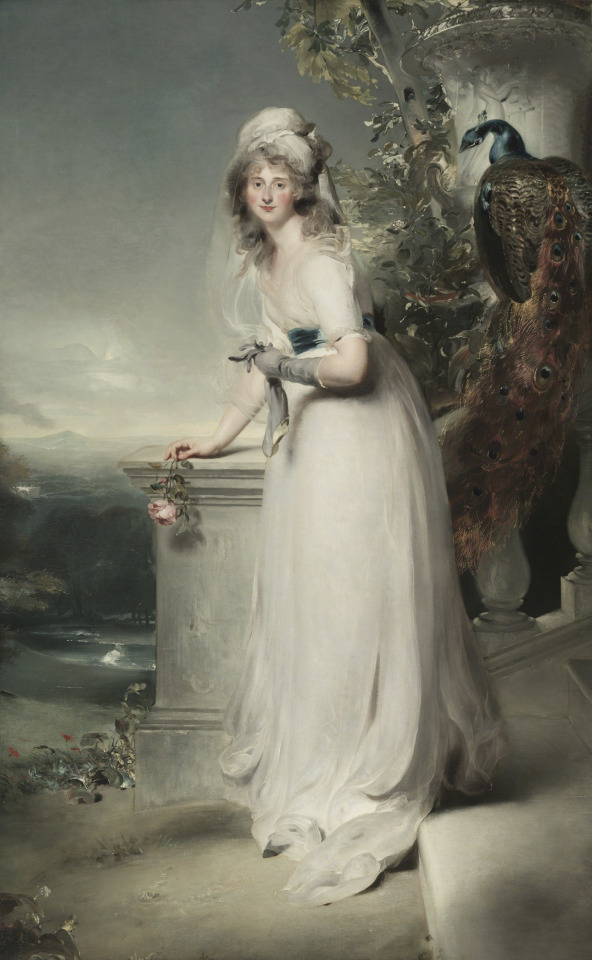
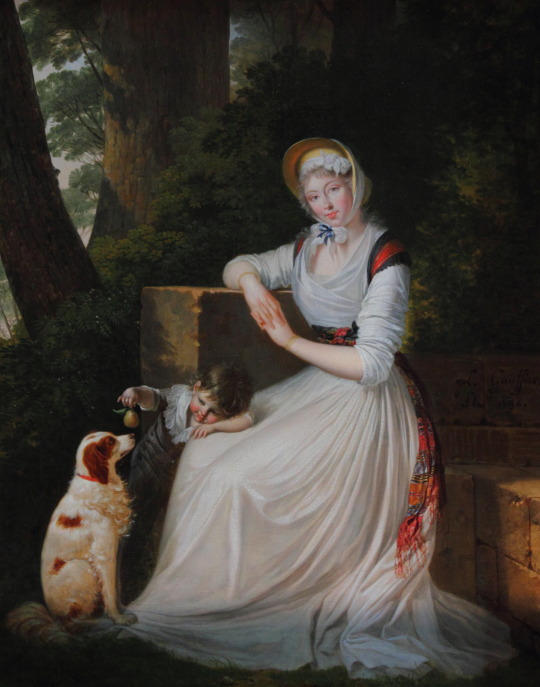
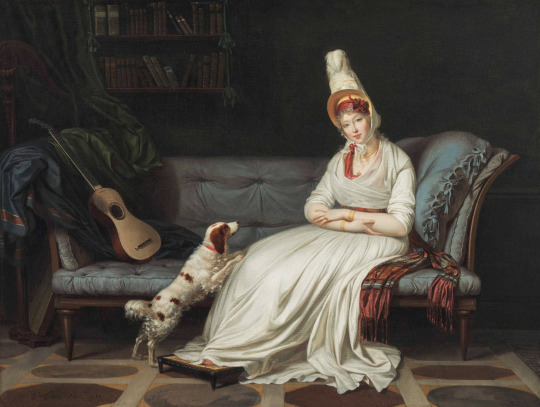
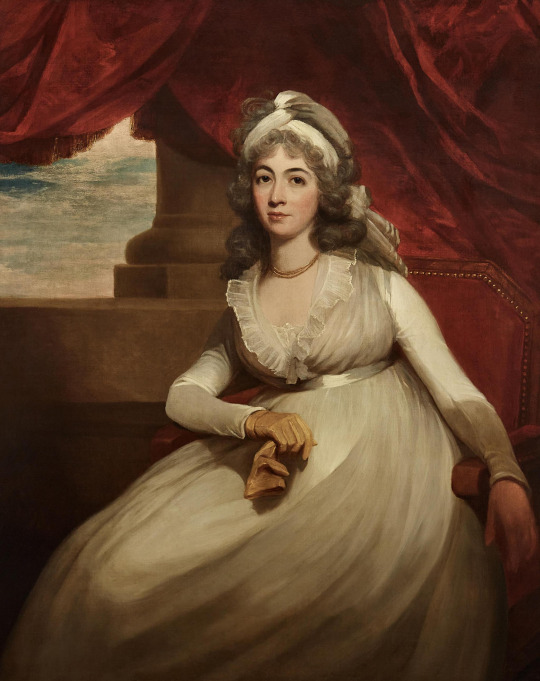
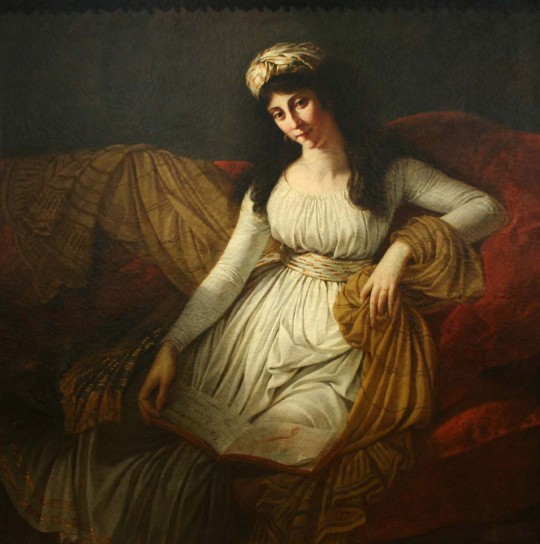

1790s dresses - Some dresses belong in the French court of Marie Antoinette while others show Greco-Roman influence.
Top 1790 Marianne Dorothy Harland, Later Mrs. William Dalrymple by Richard Cosway (location ?). From tumblr.com/sims4rococo76; fixed edges, sots, & flaws w Pshop 1280X989.
Second row 1790 Presumed portrait of the Marquise de Lafayette by Adélaïde Labille-Guiard (National Museum of Women in the Arts - Washington, DC, USA). From Wikimedia 2564X3175.
Third row ca. 1790 Marquise de Grécourt, née de la Fresnaye by Jean Laurent Mosnier (auctioned by Christie's). From their Web site 951X1186.
Fourth row 1791 Mme. de Genlis playing a harp by François Guérin (location ?). From books0977.tumblr.com/image/88627828797 797X900.
Fifth row 1794 Catherine Grey, Lady Manners by Sir Thomas Lawrence (Cleveland Museum of Art - Cleveland, Ohio, USA). From their Web site 2774X4495 @150 14.1Mj.
Sixth row left 1794 Elizabeth Holland avec son fils by Louis Gauffier (Musée Fabre - Montpellier, Hérault, Occitanie, France). From Wikimedia 2739X3483.
Sixth row right 1795 Elizabeth, Lady Webster by Louis Gauffier (Christie's - Live auction 14277 Lot 51). From their Web site. From their Web site; fixed spots & flaws w Pshop 4026X3032.
Seventh row ca. 1795 Anne, Duchess of Cumberland by Sir Martin Archer Shee (private collection), From tumblr.com/fashion-inspiration-s; fixed spots w Pshop 2048X2852 @72 984kj.
Eighth row left 1795 Madame Fravega by Antoine-Jean Gros (Musée des beaux-arts de Marseille - Marseille, Bouches-du-Rhône, Provence-Alpes-Côte d'Azur, France). From Wikimedia; fixed spots w Pshop and cropped 1544X1555.
Eighth row right ca. 1796 Madame Boyer-Fonfrède and Son by François-André Vincent (location ?). From tumblr.com/silverfoxstole; fixed spots & blurred background w Pshop 730X888.
#1790s fashion#Directoire fashion#late Georgian fashion#Marianne Dorothy Harland#Richard Cosway#high coiffure#full skirt#Marquise de Lafayette#Adélaïde Labille-Guiard#bouffant coiffure#feathered hat#modesty piece#V décolletage#Marquise de Grécourt#curly hair#hat#fichu#Mme. de Genlism#François Guérin#V waistline#Catherine Grey#Thomas Lawrence#turban#veil#waist band#close skirt#Elizabeth Holland#Louis Gauffier#bonnet#cross over bodice
12 notes
·
View notes
Text
Clotilde de Noailles every time Lafayette does something stupid:

#shitpost#la marquise#crack#meme#writing#memes about my book#lafayette#marquis de lafayette#adrienne de lafayette#adrienne de noailles#clotilde de noailles
44 notes
·
View notes
Text


Its funny that i saw him and i thought that looks like lafayette then HE IS LAFAYETTE
#hamilton#hamiltonmusical#hamiltrash#lin manuel miranda#hamiltonmovie#hamiltonmemes#marquise de lafayette#time princess
66 notes
·
View notes